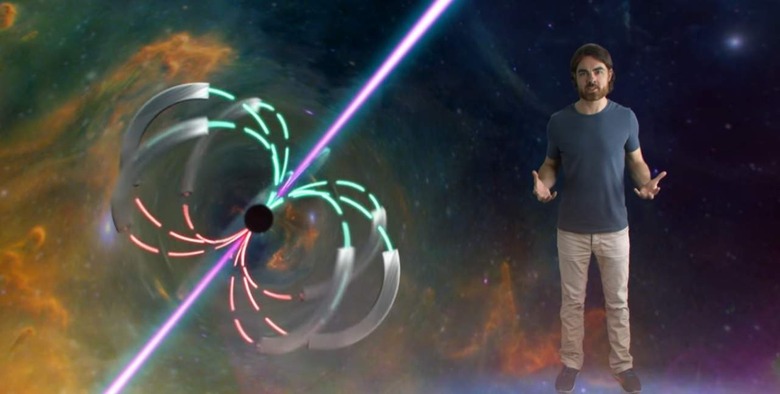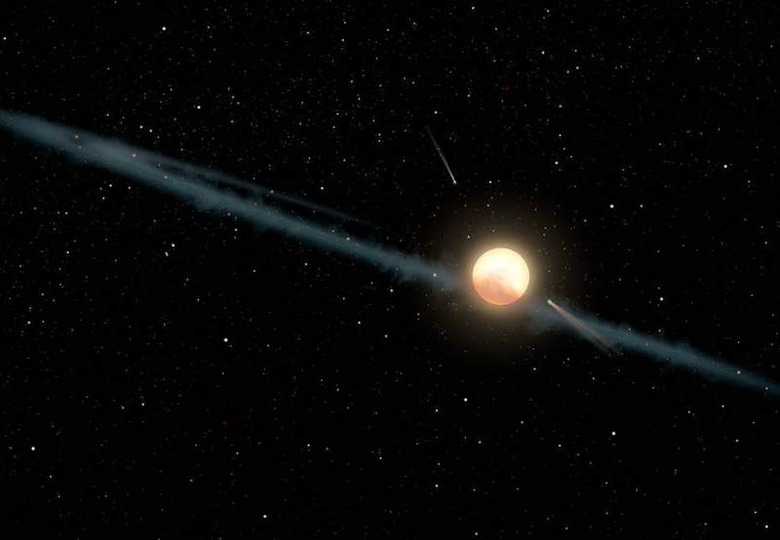The Origins Of The Dyson Sphere Explained
All of our planet's energy — whether it's gained from food, fossil fuels, or renewable sources — ultimately comes from the sun. Solar radiation makes its way 93 million miles across space to cascade upon the planet's surface. Once here, it's taken up by plants which are then consumed by animals, and the process continues. As noted by LiveScience, this process is called photosynthesis — and it powers every living thing on Earth.
The trouble is that only a small percentage of the Sun's total energy makes its way to Earth's surface (via the University of Illinois). The vast majority of the Sun's rays are lost to the expanse of space, according to National Geographic. To date, this hasn't been an issue. Nat Geo notes that the energy present on our planet exceeds our needs — but that may not always be the case.
That eventuality was the inspiration for a thought experiment cooked up by Freeman Dyson which ultimately became known as the Dyson sphere (via Earth Sky). These spheres, and similar constructions, are vast megastructures that could be built around a star in an attempt to gather all of a planetary system's available energy.
Growing energy consumption
Since the 1800s, total human energy consumption has increased from 5,600 terawatt-hours to more than 170,000 and there's no end in sight. Moreover, the rate of increase is itself increasing. As our population and technological ability grows, so too do our energy requirements, as Nat Geo noted. Given enough time, those requirements could exceed what's available on our planet, requiring us to look elsewhere for power.
The sun is a seemingly endless supply of energy, even at this vast distance. Every hour, more solar energy strikes the surface of the Earth than the whole of humanity will consume in a year. You might think that means we'll never overwhelm Earth's available energy, but that might not be the case. The biggest limiting factor in using unlimited amounts of the sun's energy is our ability to convert it effectively into useable power (via Fortum). This is where the Dyson sphere could come in handy.
The World, The Flesh, and The Devil by John Desmond Bernal
In 1929, John Desmond Bernal published his story "The World, The Flesh, and the Devil." The story explores the ways humanity might change in the future as a result of science and technology, modifying our bodies, and exploring space.
Perhaps the book's greatest accomplishment is the invention of large-scale space habitats for explorers to live inside. These flying habitats were imagined as large spheres with people living along their interior surface like a planet flipped inside out.
Prior to Bernal, no one that we're aware of ever imagined large space-based habitats which were spherical in shape and mimicked Earth-like environments. Bernal's invention has inspired generations of scientists and storytellers looking to imagine the future of humanity as we spread toward the stars.
These structures have shown up in movies including "2001: A Space Odyssey" and "Elysium," as well as TV shows like "Star Trek" and "Babylon 5." NASA even funded researchers in the '70s to figure out if we could build large space habitats.
Star Maker by Olaf Stapledon
Craig Schumaker, Littlehampton Book Services Ltd
Less than a decade after Bernal crafted his famed habitats, Olaf Stapledon wrote his most scientifically important work, "Star Maker." While some of his other stories have been adapted to the screen, "Star Maker" left its mark on science by taking Bernal's idea to the next stage. At the time of its writing, it was beloved by other science fiction creators including genre luminaries like Arthur C. Clarke. It follows a narrator who is transported through space to explore other places, encountering the titular star maker.
While the book is largely a philosophical exploration of humanity, it introduced a number of interesting ideas about the way societies could build themselves up in the infinite reaches of our universe. In the course of his travels, the narrator encounters alien species, and importantly, huge megastructures surrounding a star.
The idea of a megastructure surrounding a star would eventually make its way into countless other science fiction tales (via Goodreads). But the influence of that idea didn't end in literary circles. Decades later, scientists would take the idea of megastructures around stars and wonder if they could really exist.
Freeman Dyson popularizes the Dyson sphere
Taking inspiration from Olaf Stapledon, and possibly John Desmond Bernal, Freeman Dyson formalized the idea of stellar megastructures in his paper "Search for Artificial Stellar Sources of Infrared Radiation," published in the journal Science.
In this short paper, Dyson proposed that structures like those suggested in Stapledon's novel might be an inevitable consequence of long-standing advanced species, and that searching for their signals could reveal intelligent life elsewhere in the universe. The idea builds on the notion that, supposing a species avoids being wiped out, their energy consumption should continue to increase, and eventually they would need to find ways to acquire a significant portion of their parent star's thermal energy. If that's the case, we should be able to see signs of massive energy-acquiring structures when looking at the stars with our telescopes.
The paper not only suggested the possibility of Dyson spheres, but also outlined ways in which we might be able to find them. Dyson made the argument that the recently initiated SETI program might look for signs of stellar megastructures in addition to radio signals in the search for extraterrestrial life. As a result of this paper, Dyson acquired newfound fame and his name was inextricably linked with the premise, whether he liked it or not. Thus, the popular notion of the Dyson sphere was born, and science fiction was forever changed.
The Kardashev scale
These ideas continued to build on one another, as ideas tend to do, and four years after Freeman Dyson's paper, Soviet astronomer Nikolai Kardashev proposed a scale for measuring the technological advancement of civilizations. The Kardashev scale proposes three main types of civilization based entirely on the amount of energy they are able to extract from their environment. Sadly, humanity hasn't even attained level one, leaving us firmly in an adolescent phase of our development.
According to Kardashev's scale, level one civilizations are capable of controlling all of the energy from their home planet. As previously discussed, humanity currently controls only a small fraction of the energy delivered to us by the sun. Though, given a stable rate of expansion that could change relatively quickly, at least on a cosmic timescale.
Level two civilizations are capable of controlling all of the energy from their parent star. This is where Dyson spheres enter the picture. Capturing that level of energy would require massive structures on the level of Stapledon and Dyson's invention. Finally, level three civilizations control all of the energy from their galaxy, possibly by employing structures like Dyson spheres on a grand scale. If level three civilizations exist, and they look anything like what Futurism outlines, they should be pretty easy to spot unless they've found clever ways of hiding the consequences of their energy harvesting.
Dyson's regret
Despite gaining a level of fame and respectability among scientists and science fiction fans, Freeman Dyson came to regret the association of his name with stellar megastructures. More than that, he regretted the popular understanding of these megastructures as fully enclosed spheres around a star. Dyson later clarified in an interview that instead of a sphere enclosing a star, he actually imagined a swarm of orbiting crafts that might more closely resemble a cloud of dust. He blamed science fiction writers for taking his idea and changing it to the sorts of things we see in popular culture.
Despite efforts throughout his life, Dyson was unable to dial back the popular notion of Dyson spheres and also couldn't divorce himself from the name. In that same interview, he stated that the spheres were not invented by him and that a more correct name would be the Stapledon sphere, but by then the name had stuck.
To Dyson's great regret, ideas often take on a life of their own and don't remain under the control of their creators or popularizers. For better or worse, it seems that we're stuck with the name and the image of enclosed spheres.
Are Dyson spheres inevitable?
In Freeman Dyson's paper, he argued that a regular expansion of 1% per year in energy consumption would result in a budget of 10 to the 12th power greater than our current needs. Shortly thereafter our energy needs would outpace what could be delivered by the Sun onto the surface of the planet. Humanity could solve this problem in a number of ways, one of which is to spread into the solar system and the greater galaxy, taking in energy falling onto other planets or from other stars.
He also suggested another solution in the paper. Building a sphere around the Sun could be accomplished with the material available in Jupiter. Certainly, it's a Herculean task but could be done with the energy given by the Sun over the course of 800 years, possibly by spinning the planet up to the point that it breaks apart.
Such an engineering project feels entirely in the realm of science fiction but so might modern living, if explained to a human from only a few thousand years ago. Given enough time and technology, using other planets in order to enhance our energy harvesting abilities might be the best way for us to meet our needs.
Although, Jupiter offers more to humanity than pure resources and breaking it up to build a vast machine might not be the best idea.
Types of Dyson sphere
Three are three main types of Dyson spheres usually imagined in science and science fiction (via Space). The enclosed sphere is usually what's thought of when we talk about a Dyson sphere but it's actually the least likely to work. A better design might be a Dyson swarm like the one actually envisioned by Dyson, a collection of separate orbiting crafts which would include livable habitats and energy collectors. A swarm has many of the advantages of a sphere in terms of energy collection without the hassle of needing the whole structure to maintain integrity. Keeping everything in stable orbits could be an issue akin to our current space pollution problem but on a much larger scale.
Another alternative is the Dyson ring of the type seen in Larry Niven's "Ringworld" novel, or the Halo video game franchise. An orbiting ring could be spun up to generate artificial gravity on the ring's interior. It would essentially be a large Bernal sphere constructed around a star. Each of these constructions has its own set of benefits and challenges and it's unlikely we'll know for sure which one is best until such time as we have an opportunity to try and build one.
How we might find one
NASA GSFC/CIL/Adriana Manrique Gutierrez
Looking for Dyson spheres gets to the crux of Dyson's actual intent, as he notes in his paper, searching for advanced alien civilizations in the reaches of space. Dyson was clear that structures of this size should result in a measurable change around the parent star, even when looking from our distant vantage point.
Physics demands that the energy captured from a star must radiate away from the structure in the form of waste heat (via Jason Wright, Pennsylvania State University). Even if a sphere were to completely enclose a star, blocking out its visible light, that energy would radiate from the surface of the sphere in the form of infrared radiation.
Regardless of the structure of the sphere — whether an enclosed sphere, a ring, or a swarm — we might be able to find them by looking for the light and thermal signatures left behind. If ever we find a star that appears to be unusually shifted into the infrared, that might mean we're looking at alien megastructures. Telescopes like the recently launched James Webb Space Telescope could be particularly useful in searching for these infrared signatures.
Several programs are doing just that, searching the night sky for signs that portions of a star's light are being unnaturally blocked, or for those stars with infrared structures higher than should be expected.
Possible sighting!
In January of 2016 a group of astronomers using the Kepler Space Telescope observed something unusual around an otherwise inconspicuous star known as KIC 8462852, also known as Tabby's star. Their observations showed the star'sss luminosity dimming substantially before returning to full brightness.
Finding a star with varying brightness over time isn't wholly unusual. In fact, it's one of the key ways that we identify exoplanets (via NASA). However, in this case, the dimming was huge, on the order of 20% of the star's total luminosity. Moreover, it happened at irregular intervals. If the dimming were caused by a planet orbiting the star, we would expect it to occur at regular intervals as the planet orbited and passed in front of the star.
The combination of high dimming and the irregular pattern of dimming led some scientists to suggest it might be the result of artificial structures passing in front of the star. Other possible explanations involve closely orbiting comets near the star, though the unusual intervals of their passing continue to stymy astronomers. It's good practice to assume that an explanation is almost never extraterrestrial, but scientists are rightly intrigued and continue to investigate the star.
Building a Dyson sphere (or swarm, or whatever)
The ridiculous amount of material needed to create a structure large enough to enclose a star is certainly one hurdle to building one, but it isn't even the most important engineering problem. A structure that large could collapse under its own gravity and would require materials much stronger than any known in order to hold its shape.
Supposing we could come up with those materials, there's still the problem of orbit. A spherical object surrounding a star would not be stable in its orbit. Variances in mass inside the sphere could pull it out of true and the passing of other planets would have some impact on the whole system. It's likely the sphere would begin to wobble and eventually catastrophically fall out of orbit.
Additionally, even if it were spun up, artificial gravity on the interior would only occur along the equator, limiting the amount of livable space. The better solution appears to be a Dyson swarm and we might be able to get the proverbial ball rolling on something like that by mining Mercury or other planets. Though, some scientists perhaps rightly believe a project is well outside our technological reach.
Intentionally building a Dyson swarm from scratch is probably not our best approach, though it might be an unintended consequence of incremental engineering over time. In any case, the other planets in our solar system might be orbiting on borrowed time.
Why farm a star when a black hole is better?
If the goal is harvesting immense amounts of energy, then building a structure around a star is a good start. The total energy released by the Sun is about a billion times more than what reaches the Earth, and some portion of that is absorbed by the atmosphere. You can go a long way by farming a star.
As energy-intensive as stars are, black holes might be better, according to a recent paper published in the Monthly Notices of the Royal Astronomical Society. Collecting energy from a star is limited to the radiation coming off that star. Around a black hole, advanced alien civilizations would have five additional energy streams to play with. The paper suggests that a Dyson sphere around a black hole could harvest energy from the cosmic microwave background, Hawking radiation, the accretion disc, the corona, and relativistic jets.
Taking all of that into account, the paper suggests that a Dyson sphere around a black hole could harvest roughly five times more energy than that available around a star. The good news for us is that such a structure would radiate the same sorts of infrared signatures as those around a star. While they would be more complex to build, they should be just as easy for us to locate if they exist.
The Dyson sphere's legacy
Ideas are powerful. The idea of a Dyson sphere is perhaps even more powerful than a Dyson sphere itself, at least in the way it has inspired generations of scientists and storytellers. Dyson spheres might not exist in reality (at least until we build one ourselves) but they certainly exist in our minds, and they offer all sorts of ways for us to explore what it means to be a human being living in a vast universe.
Some version of the Dyson sphere has appeared in scores of science fiction stories from the "Halo" video game franchise to episodes of "Star Trek." They've provided a nearly endless energy source for the villains of the "Bobiverse" and provided an interesting and unique setting for the inhabitants of "Ringworld." Whether or not we ever find confirmed evidence of a Dyson sphere out there in the great cosmic expanse, their impact on our imaginations is without measure. Maybe one day we'll find a way to bring those imaginings into reality and use its power to journey into the stars.
We can dream.












